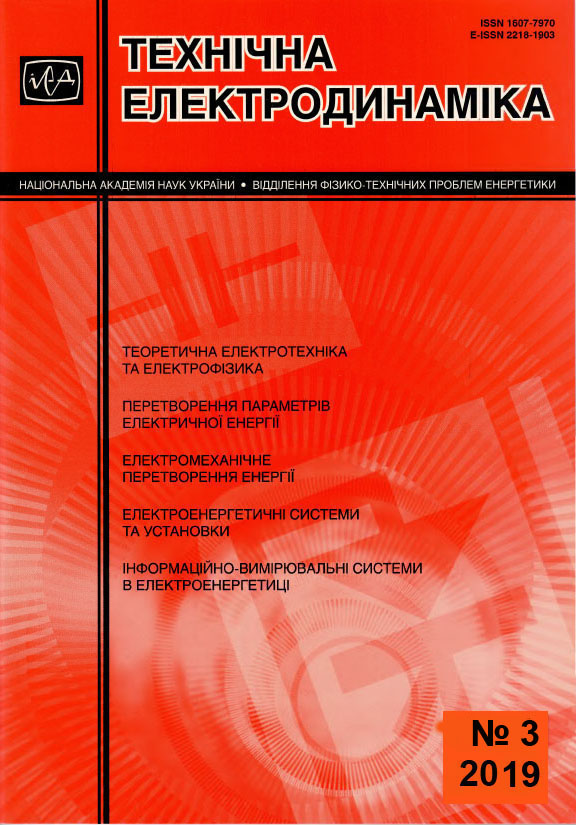Abstract
The purpose of the work is to determine the factors that affect the value of touch voltage during the synthesis of recommendations for reconstruction of the grounding while minimizing labor and material costs. The dependences of the touch voltage on the single-phase ground fault current, the soil electrophysical characteristics, the design of the
grounding, and the base resistance in the place, where equipment is serviced, are investigated. At the same time, statistical data of the energy objects, where measurements were carried out, tools for mathematical modeling of the electrical potential distribution in the grounding device and methods of physical experiment were used. In the paper the
value of the saturation current for a fixed size of a uniform grounding grid is determined, taking into account the influence of all four types of three-layer soil on the touch voltage. The asymmetry of the touch voltage distribution along the equipment lines depending on the distance to the grounding edge is shown. According to results, the research directions have been formed to develop the unified methodology for the synthesis of recommendations for reconstruction of the grounding using the predictive model of the touch voltage assessment before calculations. References 15, figures 6, table 2.
References
BS EN 50522:2010. Earthing of power installations exceeding 1 kV a.c. London, BSI, 2012, 104 р.
Rules of the device electroinstallations. General rules. Kyiv: Mіnenerhovuhіllia Ukrainy, 2014. 793 p. (Ukr)
Verordnung über elektrische Starkstromanlagen (Starkstromverordnung). Bern: Der Schweizerische Bundesrat, 2016, 34 p. (D)
Koliushko D.G., Rudenko S.S., Koliushko G.M. Analysis state of grounding grids of existing power plants of Ukraine. Bulleten Natsionalnoho Tekhnichnoho Universytetu KhPI. 2017. № 15 (1237). Pp. 44-48. (Rus)
Cardoso C., Filipe N., Leiria A., Teixeira P. An integrated methodology for design of grounding systems, Proc. 23rd Conference on Electricity Distribution., Lion, France. 15-18 June, 2015. Pp. 1–5.
Cardoso C., Filipe N., Leiria A., Teixeira P. Validation of an integrated methodology for design of grounding systems through field measurements. CIRED. 2017. Iss. 1. Pp. 897–901.
Prasad D., Sharma H.C. Parameters Effecting Substation Grounding Grid Resistance. International Journal of Research in Engineering and Applied Sciences. 2015. Vol. 5. Iss. 10. Pp. 30–37.
Gilbert G. High Voltage Grounding Systems: author's abstract of PhD diss.: department of Electrical and Computer Engineering. University of Waterloo. Waterloo. Ontario, Canada. 2011. 88 p.
Wu X., Simha V., Wellman R.J. Optimal ground grid design for large EHV substations with autotransformer. IEEE Power & Energy Society General Meeting, Denver. 2015. Pp. 1-5.
IEEE Std. 80-2000. Guide for Safety in AC Substation Grounding. New York, NY: IEEE, 2000. 192 p.
Shishigin D.S. Methods of the theory of grounding for the analysis of electromagnetic compatibility and lightning protection of electrical substations: author's abstract of PhDr diss: 05.09.05. St. Petersburg State Polytechnic University. St. Petersburg. 2017. 137 p. (Rus)
Nizhevskyi I.V., Nizhevskyi V.I., Shishigin S.L. Research on electric potentials alignment on the ground surface within the grounding conductor territory. Electrical engineering & Electromechanics. 2014. No 4. Pp. 71-77. (Rus)
Test and control devices, electrical grounding. Standard instruction. SOU 31.2-21677681-19:2009. Kyiv: Mіnenerhovuhіllia Ukrainy, 2010. 54 p. (Ukr)
Rudenko S.S., Koliushko D.G., Kashcheyev O.V. Determination of direction to reconstruction of grounding system. Electrical engineering & Electromechanics. 2017. No 2. Pp. 57-61. DOI: https://doi.org/10.20998/2074-272X.2017.2.09
Koliushko D.G., Rudenko S.S. Determination the electrical potential of a created grounding device in a three-layer ground. Tekhnichna Elektrodynamika. 2018. No 4. Pp. 19–24. DOI: https://doi.org/10.15407/techned2018.04.019

This work is licensed under a Creative Commons Attribution-NonCommercial-NoDerivatives 4.0 International License.
Copyright (c) 2022 Array






